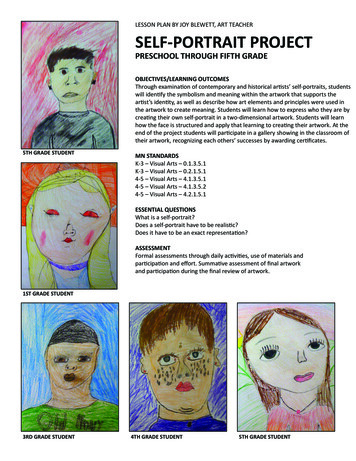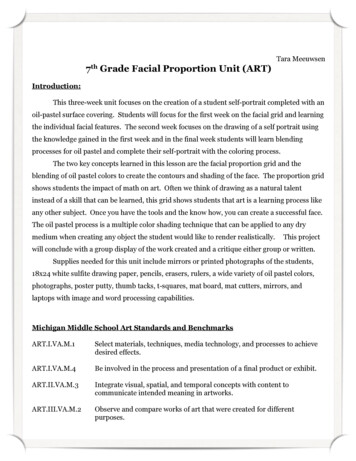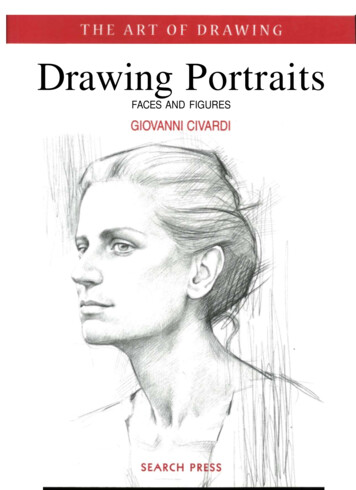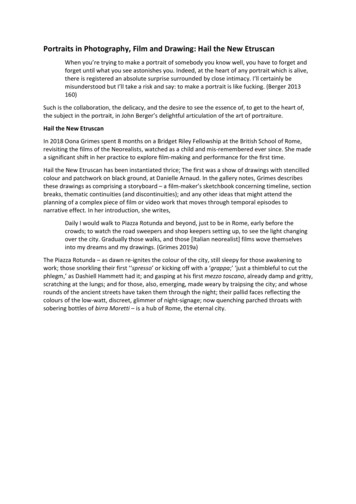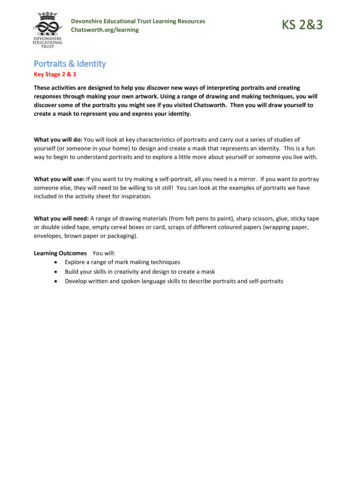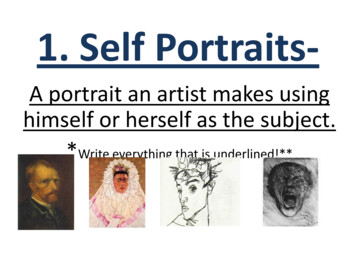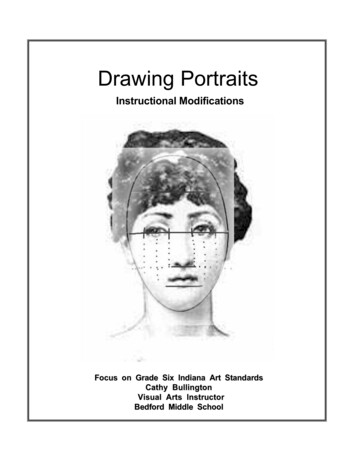
Transcription
Drawing PortraitsInstructional ModificationsFocus on Grade Six Indiana Art StandardsC a t h y B ull i n gt o nV is u a l A r t s I ns t r u c t orBedford Middle School
Dear Teacher:I am an art teacher at Bedford Middle School in Bedford, Indiana. I teach art to sixth, seventhand eighth graders. Every nine weeks, the students rotate to another teacher on the EssentialSkills team. Our school has students with a wide range of abilities. Inclusion has been inpractice for the visual arts courses for many years. Visual arts is one area where studentsthat struggle with reading and math can have success.The Portraits Unit is taught for one week to the Sixth Grade and is referred back to for reviewduring Seventh and Eighth grade Figure Drawing. In this lesson, I will show possiblemodifications and technology options to assist in teaching how to create a portrait. Uponcompleting the Portraits Unit, most students will be able to draw a realistic face with correctproportions. Students will also be able to identify and discuss famous portraits and possiblecareers in art.The Portraits Unit works well with the other courses across curriculum. The proportions tie inwith Math. The features and bone structure and musculature tie in with Health. Using famousportraits such as the “ Mona Lisa” or “George Washington” can tie in with Social Studies. Selfportraits can also tie in with journaling in English classes. Careers such as police sketchartist, plastic surgeon, aesthetician, and animation artist can be discussed.Cathy BullingtonBedford Middle Schoolbullingtonc@nlcs.k12.in.usImage of Lina Cavalieri used for background, coverpage, and this page, courtesy .jpg-2-
Standards:Bedford Middle School follows the Indiana Academic Standards for Visual s/2002-08-28-INVisArtsStandard.pdfThe Visual Arts Standards addressed in this unit are:Responding to Art: HistoryStandard 1:Students understand the significance of visual art in relation to historical, social,political, spiritual, environmental, technological, and economic issues.Creating Art: ProductionStandard 7:Students observe, select, and utilize a range of subject matter, symbols, and ideas intheir work.6.7.1.1 Produce art that demonstrates refined observational skills indrawing from life.Standard 8:Students understand and apply elements and principles of design effectively in theirwork.Standard 9:Students develop and apply skills using a variety of two dimensional and threedimensional media, tools, and processes to create works that communicate personalmeaning.Standard 10:Students reflect on, revise, and refine work using problem solving and critical thinkingskills.Careers and CommunityStandard 11:Students recognize a variety of art-related professions and careers in our society.Integrated StudiesStandard 13:Students identify and make connections between knowledge and skill in art and allother subject areas such as humanities, sciences, and technology.-3-
PlanningPyramidSomeMostAllPyramid clipart from Microsoft OfficeSome students will :Create a portrait that captures expression and a likeness to the subject. Useshading to show depth and create the illusion of three-dimensional form.Most students will :Draw an egg for the face shape. Create a portrait based on life observation thatis of the correct proportions with accurate features. Use the guidelines to divideup the face into the correct proportions. Use some shading to show form.Recognize famous portraits by famous artists. Recognize career connections.Identify and make connections to other parts of the curriculum such as math andhealth. Revise work after comparing it to guidelines and checking proportions.All students will :Know what a self-portrait is. Understand the difference between a front view, aprofile view and a three-quarter view portrait. Draw a face that includes all of thefeatures placed in the correct position in relationship to each other.-4-
Teacher LibraryCorrect face rials.cfm“I Can Draw Faces” f sib dp pt/104-5868547-8335927#reader-linkVideo on drawing faces with teacher guide and National Educational Standards :http://gpn.unl.edu/midd product.asp?catalog%5Fname GPN&category%5Fname Doodle%21&product%5Fid ://gpn.unl.edu/displaystandards.asp?catalog%5Fname GPN&category%5Fname Doodle%21&product%5Fid 755%2E001Portraits from Museum //www.npg.org.uk/live/index.aspThe World’s Most Famous itesciences.fr/english/ala w.louvre.fr/louvrea.htmWarhol style portrait ol.htmlLesson ns/personalPortraits.jspInteractive sites to use with the ord-artedventures.com/create/tech face eate/tech portrait /crimedetection/index.html-5-
Learner ActivitiesWeb 1.htmlhttp://www.kidpix.com/kid du/art/rt ead.com/Lab Activities: Draw faces using software such as Paint, Kid Pix, Paint Shop-Pro, Adobe Photoshop. Take digital photographs and check face proportions in imaging software by applyinggrid to face. (Math—fractions, geometry) Scan in photos and alter by skewing, stretching, colorizing, adding poster effects,changing contrast. Take digital photos of different expressions and create an online catalog. Take digital photos of parts of the face to create an online catalog. Create a webpage tutorial on drawing faces. Create a Warhol inspired portrait by altering, colorizing and repetition.SMART Board Activities: Scan or import a famous portrait into SMART Notebook and use the drawing tools toshow proportions and shapes of features. (Social Studies---why were they famous, whatwas going on when this picture was made) Teacher uses SMART Board to show students how to use imaging software. Students share Power Point presentations of portraits they have drawn or those drawn byfamous artists. Class works in groups to solve crime by drawing police artist sketch etection/index.html . (Careers-sketch artist, animation, aesthetician, plastic surgeon) Students work together as a class to create a rubric for evaluating their portraits. Students portraits are scanned into SMART Notebook and compared to rubric formaking decisions about how to improve their drawings.Studio Activities: Students take turns drawing each other.Students draw themselves using mirrors and/or photos.Students draw from masterworks.Students grid pictures of faces from magazines and then enlarge them on their drawingpaper.Students create “Wanted” Posters of famous people or teachers.Students create a brochure about their favorite famous portrait.Students create posters showing the skeleton and muscles in the head. (Health)Students use Dana by Alphasmart to create a mood journal and add illustrations fromtheir photos or drawings that show expression. (English)-6-Cross-Curricular tie-ins are in parantheses
AssessmentVisual Arts gives students a great deal of freedom in creating a product for assessment oflearning. I have created a list of possible products and a list of sources for creatingassessments for those products. Some students may need to create an alternative product ormay need an alternative assessment of their product in order to fulfill the accommodations asoutlined in their Individualized Education Plan. Students not having an IEP will also benefitfrom the flexibility of having choices.Possible Products: Self-PortraitDrawing from a masterworkDrawing from lifeBrochure about a famous portraitDigital drawings—scanned and altered, gridded to show proportionsWebpage catalog of expressions or facial featuresClass presentation of student portfolio—speech, Power-point, slideshow,webpage“Wanted” postersMood journal with illustrations of expressions that show moodPresentation about careers where the knowledge of the facial features isimportantPoster showing facial proportions and methods of griddingPossible Assessments: Checklist created at http://pblchecklist.4teachers.org/checklist.shtml Rubrics for individual products or portfolios can be created athttp://rubistar.4teachers.org/ Student created rubric—teacher models or teaches how to create Rubric for verbalization on art http://www.goshen.edu/art/ed/rubric3.html Rubric for evaluating an art product http://www.goshen.edu/art/ed/rubric2.html A variety of rubrics and forms for evaluating III1.pdf A variety of tools to fit different ssess.html Offers ideas and definitions for a variety of sme/aindex.htm?-7-
ModificationsAcademic Diversity Planhttp://ericec.org/ is the website of The Council for Exceptional Children.You will find information and links to resources for a variety of needs of thesestudents. It is important to understand that students may not fall into onecategory. If a modification is not working, try another one. Ask the student, theirparent, or another teacher what seems to help them. You may need to modify forany of the following:Non-ReadersPhysical ImpairmentsVision ImpairmentsHearing ImpairmentsAttention/Behavior DifficultiesAutismEmotional and Behavior DisorderMild Intellectual DisabilityOrthopedic ImpairmentAttention Deficit/Hyperactivity DisorderTourette SyndromeSpecific Learning DisabilitySpeech-Language ImpairmentTraumatic Brain InjuryGiftedIn visual arts, you may find that your most gifted students are students that have an IEPand that they struggle with academic classroom work. The visual arts have an instantappeal for the exceptional students in that most of the work is visual—not written, notmathematical, not only one answer. Some believe this has to do with right-brain and leftbrain thinking. http://www.drawright.com/theory.htm Most art teachers draw an exampleon the board as well as talk the student through the steps and write out the assignmenton the board. There are many artists who were considered exceptional and they andtheir work can be used as examples in class.Another appeal to visual arts is that the products created for assessment can be sovaried. The following pages list a few possible modifications to consider as they applyto visual arts.-8-
Modifications cont’dPhysical Arrangements: Preferential seating—close to front to see and hear, in back so can stand while working,close to door so can take breaks. Create a non-distracting work area---only have visuals out that tie in with the currentlesson, light or windows to back of students. Tape down drawing paper or use clipboards. Allow to tilt desk top. Face students when talking. Post classroom rules, procedures and consequences. Keep aisles clear of backpacks. Create and follow a daily schedule.Lesson Presentation: Pre-teach by providing notes, vocabulary and schedule ahead of time.Provide fill-in-the-blank notes to be used during instructions and lectures.Create notes that have only a few steps per page.Provide desk visual aids so students have something to touch.Provide large print notes.Tape record written notes, text, and instructions.Enlarge visuals and materials.Allow the students to use headphones to listen to tapes or to block out distracting noise.Simplify assignments into smaller steps, tasks.Use buddy system to check for understanding as teacher presents instructions.Use students as helpers for passing out supplies and cleanup.Use examples of artists that were also exceptional without directly pointing out that theywere exceptional.Assignments/Products: Use buddy system to peer tutor.Allow gifted students to teach a portion of a lesson or to be a tutor.Allow students to choose from several products.Allow students to trace at first as practice.Allow students to fold paper to use as guidelines or to use a paper guideline underneaththeir drawing.Allow students to videotape presentations ahead of time.Provide samples of what finished products should look like.Have students turn work upside down to draw to look at shapes only instead of content.Allow students to do group work.Allow students to use computer drawing software to create their work.Create a template or layer for students to use as a guideline in computer work.Provide checklists for completing work.-9-
Modifications cont’dMedia and Tools: Provide larger paper to allow for larger arm movements. Allow to use computers to do drawings and provide templates or layers to use withsoftware. If using computers, check display and accessibility options. Allow choice of drawing tools. Provide adaptive aids for drawing tools. Allow use of teacher made stencils.Assessments: Provide self-check lists.Provide rubric for grading when project is assigned.Break down assignments and assessments into smaller parts.Allow extra time for completion.Allow partner or group work.Use a portfolio and grade for improvement or achieving skills.Don’t wait until assessment to provide positive feedback for on-task, attempts,improvement and trying new things.Resources for Art Modifications and Adaptive vegrip/Books:Special Artists Handbook: Art Activities and Adaptive Aids for Handicapped Students bySusan RodriguezChronicles of Courage : Very Special Artists by Jean Kennedy Smith and George Plimpton-10-
Students work together as a class to create a rubric for evaluating their portraits. Students portraits are scanned into SMART Notebook and compared to rubric for making decisions about how to improve their drawings. Studio Activities: Students take turns drawing each other. Students draw themselves using mirrors and/or photos.File Size: 527KB


